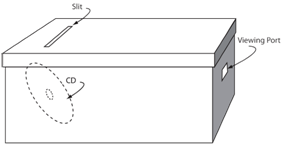- 1610: Galileo
- 1676: Ole Rømer
- 1687: Isaac Newton
- 1781: William Herschel
- 1838: Friedrich Bessel
- 1861: William and Margaret Huggins
- 1912: Henrietta Leavitt
- 1917 Einstein
- 1920: Harlow Shapley
- 1929 Edwin Hubble
- 1948: Ralph Alpher
- 1949: Fred Hoyle
- 1963: Maarten Schmidt
- 1964: Arno Penzias and Robert Wilson
- 1978: Vera Rubin and Kent Ford
- 1989: Margaret Geller and John Huchra
- 1992: John Mather and George Smoot
- 1995: Robert Williams
- 1998: Saul Perlmutter and Brian Schmidt
- 2010: Wendy Freedman
1861 Activity: Use a compact disk to make a spectroscope
The first spectroscopes used a glass prism to break up light into its constituent colors. An alternative technology for revealing the colors in light is a diffraction grating, which is a clear or reflective material with finely ruled lines. Diffraction gratings were invented around 1785 in Philadelphia by David Rittenhouse, but were initially difficult to produce. Now they can be found everywhere in the form of compact disks (CD). The “Cool Stuff” website describes how to make a simple spectroscope using a CD as follows:
|
 |
|---|
Observe the smooth rainbow of colors from an incandescent light bulb and compare it with the lines at specific colors that come from a fluorescent light. Stars have both types of spectra. The smooth spectrum of colors indicates the average temperature of the star at its visible surface, while the bright lines reveal the composition of the star. Further information on this activity is available at:
http://www.arborsci.com/CoolStuff/New_CoolStuff_Articles/cool22.aspx